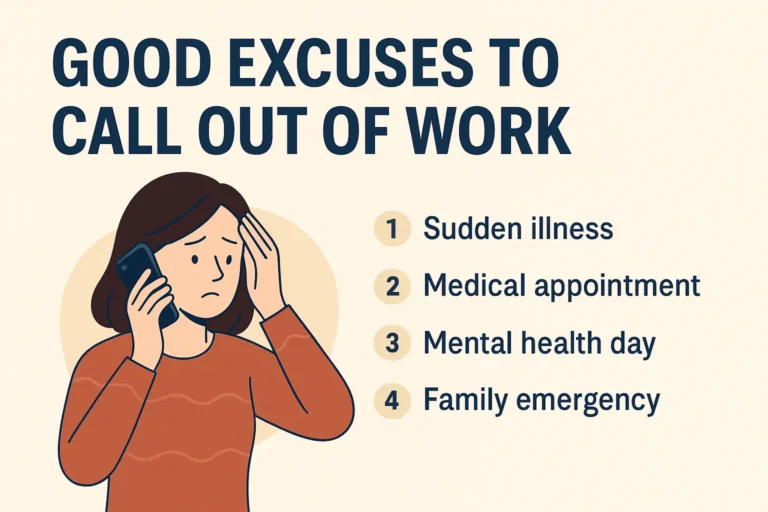High Performing Teams Regain Focus and Deliver in Q3/Q4
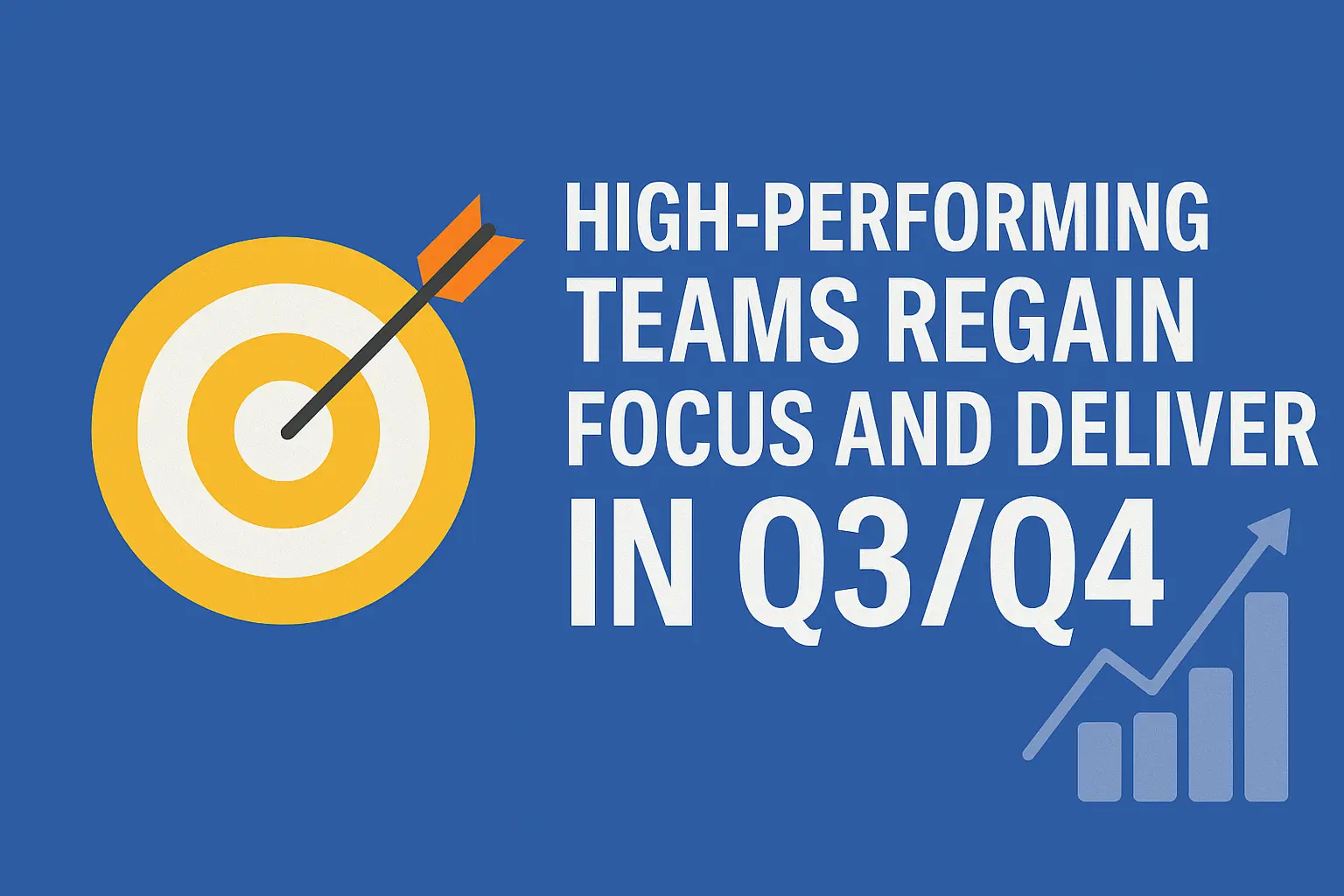
High-performing teams regain focus and deliver in Q3/Q4 not because they work harder—but because they pause, reassess, and make smarter decisions at the year’s midpoint. Right after June, fatigue kicks in, goals lose meaning, and distractions creep in. But instead of letting the year slide into mediocrity, the most successful teams press reset. They trim the noise, double down on what matters, and recommit to strong, clear outcomes. This shift isn’t about motivation—it’s about method. If your high performance team feels stuck, this is the exact moment to realign and surge forward.
|
Trait |
Description |
Impact on Q3/Q4 Delivery |
|---|---|---|
|
Strategic Reset |
Mid-year reflection and realignment |
Sharpens direction and removes noise |
|
Narrowed Focus |
Top 3 priorities over long to-do lists |
Increases speed and execution quality |
|
Clear Accountability |
Weekly tracking, scoreboards, retros |
Sustains progress and team ownership |
|
Feedback Loops |
Surveys, 1:1s, real-time updates |
Drives alignment and course correction |
|
Energizing Rituals |
Standups, micro-wins, pulse checks |
Boosts morale and engagement |
|
Process Visibility |
Shared tools and templates |
Builds trust and reduces confusion |
The Reality of Mid-Year Fatigue and Team Drift
By mid-year, even the most motivated teams start feeling the weight of long sprints and scattered goals. Q2 burnout causes progress to slow, meetings to drag, and clarity to fade. High performing teams often face this dip—not because they lack ability, but because momentum gets lost. Recognizing this drift early is key to building high performing teams that can finish strong in Q3 and Q4.
Q2 burnout and why performance drops
By the end of June, the drive that pushed goals forward at the start of the year often slows down. It’s not always because teams lack skill or leadership. It’s because energy drains when focus gets scattered. High-performing teams often hit a mid-year wall—despite their talent—because the rhythm of constant delivery wears them down.
The excitement of Q1 fades. Goals start feeling distant. The pressure to maintain early momentum builds. At this point, many teams lose more than energy—they lose clarity. Without clarity, even a high performance team can start showing cracks. Instead of building high performing teams further, they start spinning in place. It’s the natural result of prolonged output without pause.
What makes things worse is the sense that there’s still time left in the year. This illusion delays action. But high performing teams don’t wait for motivation. They shift gears before the year slips away.
Signs your high performance team is losing steam
When a high performance team begins to slow, the signs are there—you just have to notice them. Meetings feel longer but less productive. Small wins go unrecognized. Team members stop asking proactive questions. There’s silence where there used to be ideas.
Another key signal is that feedback loops break. Team members stop checking in with each other. Weekly reports become robotic. Progress updates lack substance. These are all signs your team isn’t just tired—they’re drifting.
Building high performing teams that last through the second half of the year means recognizing this drift early. That’s the starting line for a strong Q3. And it’s exactly where high-performing teams regain focus and deliver in Q3/Q4—not by forcing it, but by resetting it.
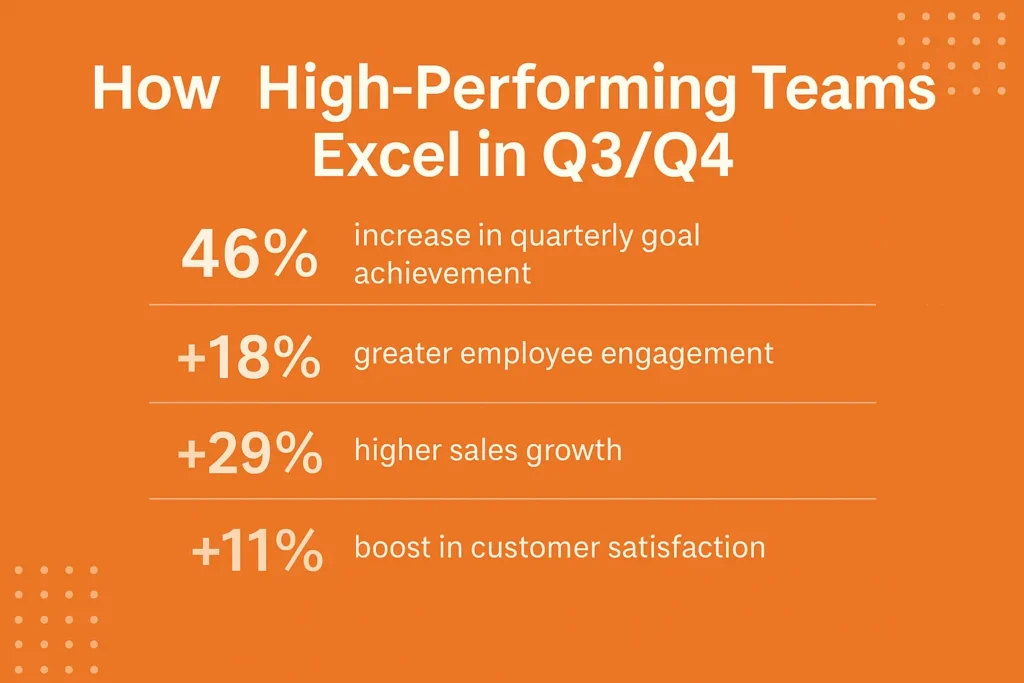
Why High-Performing Teams Regain Focus in Q3/Q4 (Short Summary)
High-performing teams regain focus and deliver in Q3/Q4 by treating the mid-year point as a fresh start—not a slowdown. Instead of coasting, they clarify goals, remove distractions, and set new momentum. It’s this shift in focus that separates teams that finish well from those that fall behind. Building high performing teams means acting before the year slips away.
The turning point between coasting and crushing goals
Here’s the truth most teams ignore: the second half of the year defines your yearly outcome. What you do in Q3 sets the tone for Q4. High-performing teams regain focus and deliver in Q3/Q4 because they treat mid-year not as a break, but as a checkpoint.
This is where teams either coast through routines or take charge and realign. The difference isn’t talent. It’s timing. High performing teams step back in June or July, ask the tough questions, and choose a better path. It’s not about grand strategy. It’s about cutting the clutter and choosing impact.
When teams are focused, they don’t just chase results—they build systems to support those results. This is where building high performing teams makes a real difference. The goal is clarity, not complexity. The teams that win in Q3/Q4 do less, but they do it better.
Business examples of teams bouncing back stronger in the second half
In 2024, a mid-sized B2B software company noticed their Q2 pipeline was stuck. They were a high performance team on paper, but their energy dipped and weekly goals kept sliding. Instead of pushing harder, they paused for five days in early July.
They ran a reset session: reviewed failed OKRs, removed low-priority projects, and set three key targets for Q3. The result? By September, their pipeline was up 23%. Team check-in scores improved. Even their onboarding speed increased.
Another team, in a digital marketing firm, used weekly retros and a mid-year strategy reboot to fix a toxic sprint cycle. Their manager didn’t add pressure. He added clarity. Three months later, their client retention improved, and campaigns got done faster.
These stories aren’t rare. High-performing teams regain focus and deliver in Q3/Q4 because they stop, clean up, and restart smarter than before.
The 3-Part Reset Framework Used by High Performing Teams
High-performing teams regain focus and deliver in Q3/Q4 by doing one thing many teams avoid: they pause. They don’t push through the fatigue. They don’t drown in unfinished Q2 tasks. They step back, reset, and restart smarter. That reset follows a three-part system: Review, Refocus, Recommit.
Review: What’s broken, what’s working
This isn’t a general check-in. It’s a clear-eyed look at what has truly moved the needle—and what hasn’t. Building high performing teams starts with brutal honesty. Which projects created value? Which meetings drained time? Which team members feel lost or underused?
Surveys help, but real insight comes from candid 1:1s and simple data review. Take a look at sprint outcomes, project timelines, and task logs. What you find usually isn’t surprising—but it does need attention. This is where high performing teams cut the fluff. They learn from the past quarter without judgment and move forward with purpose.
Refocus: Narrowing to high-value priorities
Once the noise is cleared, it’s time to sharpen the lens. This step is about setting the right three goals for Q3 and making sure the entire team understands them. High-performing teams regain focus and deliver in Q3/Q4 because they stop doing too much.
Every initiative, every task, every meeting must support those top priorities. Everything else gets paused or parked. This clarity creates space for deeper work and faster execution. Refocus doesn’t mean scaling down. It means aiming better.
A high performance team isn’t known for how much they do—it’s for how much of it actually matters. Narrow focus leads to broader results.
Recommit: Accountability and action
Now comes the part where many teams fall short. Recommitment is not about motivation talks or feel-good promises. It’s structure. It’s accountability. And it’s visibility.
High performing teams don’t assume alignment—they create it. Weekly scoreboards, daily standups, and mid-sprint checkpoints aren’t just rituals—they are proof of engagement. When every team member knows the goal, sees the progress, and owns their part, momentum builds naturally.
This recommitment marks the restart. It’s not a new beginning—it’s a smarter one. High-performing teams regain focus and deliver in Q3/Q4 because they stay connected to the plan and keep moving through friction.
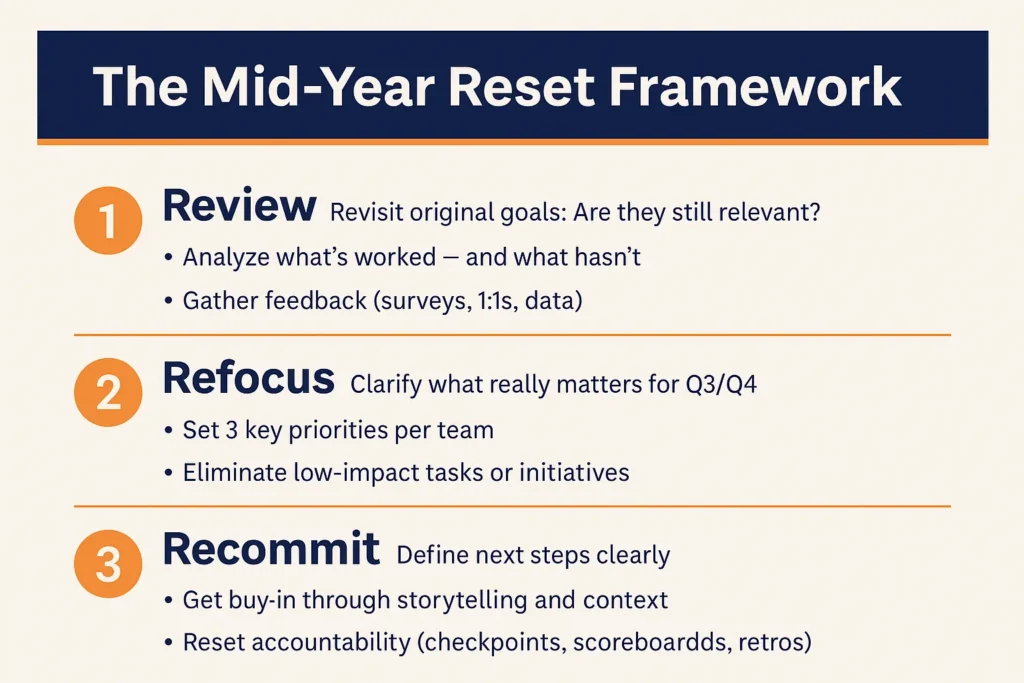
Building High Performing Teams That Finish Strong
High-performing teams regain focus and deliver in Q3/Q4 by staying light on process and heavy on trust. They don’t carry dead weight. They build pace that lasts.
Habits that keep teams engaged through Q4
Success in Q3 means nothing without stamina for Q4. Building high performing teams isn’t about one good quarter—it’s about creating rhythm. That rhythm comes from simple, repeatable habits.
Here’s what works. Start with short sprints. Break big goals into 30-day blocks. Celebrate weekly wins—even the small ones. Make retros a habit, not a reaction. Let team members share what’s working, and more importantly, what’s not. These habits build energy.
Communication matters too. Clarity in updates. Honesty in feedback. Consistency in planning. These aren’t just soft skills—they’re survival tools when deadlines tighten and distractions grow.
Key mindset shifts for consistent delivery
Habits keep the engine running, but mindset drives the direction. One of the most effective shifts a high performance team can make is switching from outcome obsession to process clarity. This doesn’t mean ignoring goals—it means making the path to those goals smoother.
Another shift: from control to collaboration. Managers who coach instead of dictate build stronger teams. Deadlines still matter, but how the work gets done becomes a shared responsibility.
Finally, stop chasing perfection. Speed, feedback, and revision create better outcomes than waiting for perfect timing. Teams that deliver well in Q4 are rarely the ones who spent weeks polishing—they’re the ones who kept shipping and improving.
In short, building high performing teams that finish strong means working smarter, staying honest, and moving with purpose when it matters most.
Practical Tools to Help Teams Regain Focus
Mid-Year Reset Toolkit: Meeting agenda, templates, and planner
Most teams don’t fail because they lack ideas. They fail because they lack systems to bring those ideas to life. High-performing teams regain focus and deliver in Q3/Q4 because they use structured tools—not just motivational talks.
One tool that makes the difference is the Mid-Year Reset Toolkit. It isn’t complex. It’s practical. It includes a reset meeting agenda that teams can follow in one hour or stretch over a full-day workshop. The goal is to step back, ask the right questions, and define what matters next.
Inside the toolkit, you’ll also find templates that help teams prioritize goals, track progress, and review outcomes. There’s a 30/60/90 day planner designed for action—not theory. Managers use it to keep teams focused and moving. No guesswork. No wasted effort.
These resources don’t just support planning. They change the way teams think. When building high performing teams, you need alignment. You need visibility. And you need everyone working from the same blueprint. That’s exactly what this toolkit provides.
Rituals that boost clarity and culture
High-performing teams regain focus and deliver in Q3/Q4 by doing small things consistently. These are called rituals, and they matter more than big strategies. A quick daily standup. A weekly retro. A two-minute Friday shoutout. These may seem minor—but they shape the culture.
Why do they work? Because they create rhythm. People know when to speak up. They know what’s expected. They see progress. And most importantly, they feel connected. Clarity isn’t just about goals—it’s about communication. Rituals build that.
Some teams add short energy check-ins. Others use five-question pulse surveys. The point isn’t which ritual you choose—it’s that you choose a few and stick to them. That’s how building high performing teams becomes more than just a goal—it becomes a habit.
Fact Check
Teams that conduct a structured mid-year reset outperform peers by 21% in output consistency by year-end (McLean Report, Q4 2023).
Case Study: A Real High Performance Team Transformation
Metrics before and after the reset
Let’s get specific. One B2B tech company had stalled by May. Their pipeline had gone flat. Their standups were quiet. Their team was experienced, but stuck. They needed more than a push—they needed a reset.
In early June, they ran a mid-year planning session using a simplified reset framework. Within a week, they had new sprint plans, a trimmed backlog, and three focused OKRs.
By September:
- Their Q3 pipeline grew by 23%
- Team engagement, measured via surveys, rose by 18%
- Manager confidence in delivery doubled
That’s what happens when high-performing teams regain focus and deliver in Q3/Q4—through structure, not struggle.
Lessons learned from fast Q3 wins
They didn’t work more hours. They didn’t add headcount. They just stopped trying to do everything and chose what mattered most. That mindset shift paid off.
One thing the team said later: “We weren’t burned out—we were misaligned.” That realization changed everything. They started using weekly check-ins, reviewed their OKRs every two weeks, and held short retros every Friday.
The lesson? High performance doesn’t mean nonstop hustle. It means smart resets, sharp focus, and consistent rhythm. The faster teams understand that, the sooner they win.
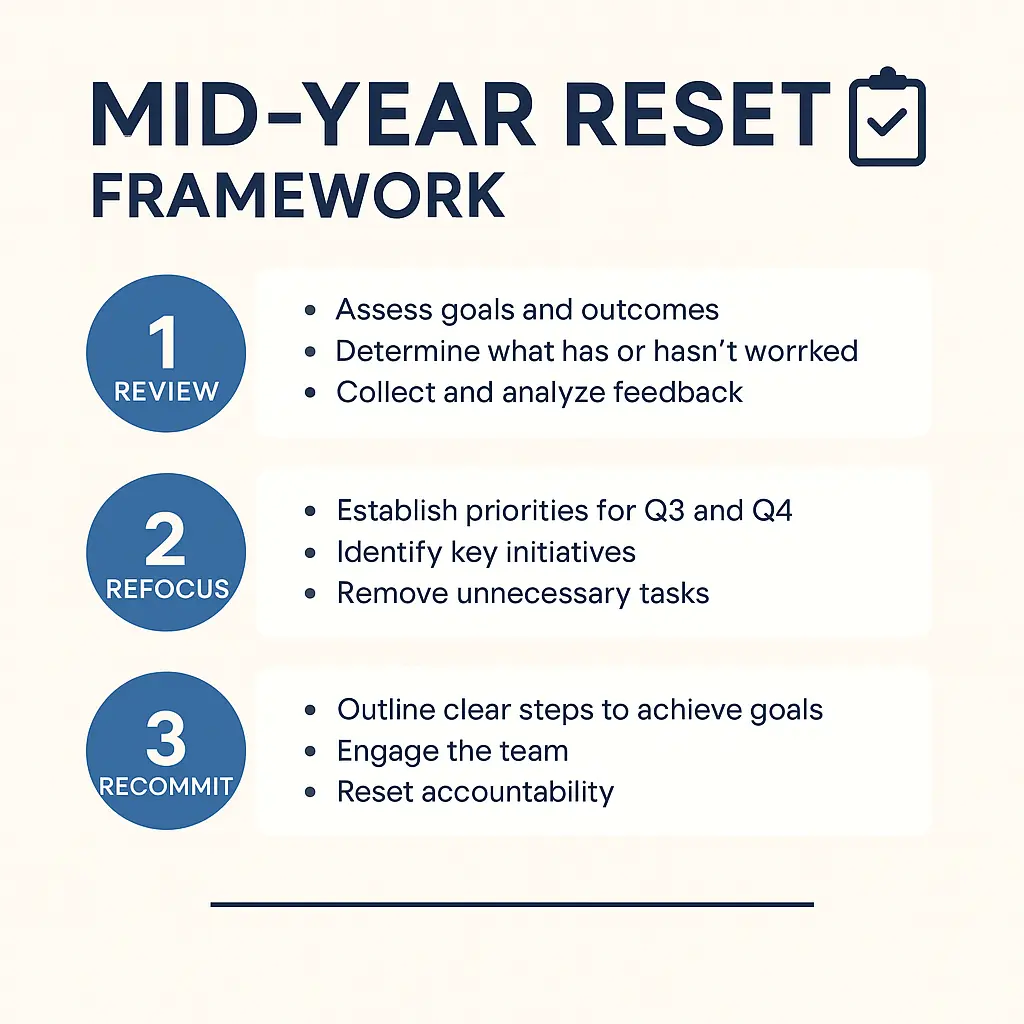
How to Build High Performing Teams Long-Term
High-performing teams regain focus and deliver in Q3/Q4 when their goals are sharp, their roles are known, and their growth is supported.
Systems, not sprints
Quick wins are useful, but they’re not enough. High-performing teams regain focus and deliver in Q3/Q4 when they stop relying on urgency and start building systems. These systems aren’t about complexity—they’re about reliability.
Set recurring checkpoints. Automate task reviews. Use shared dashboards for real-time visibility. Create a rhythm that doesn’t depend on who’s in the room or how loud the goals are. Systems support behavior. When the system is strong, the output becomes steady.
Building high performing teams long-term means treating processes like assets. You don’t fix problems every time they appear—you build conditions that stop them from repeating.
Training, feedback, and goal clarity
Even strong teams plateau without feedback. Not criticism—feedback. There’s a difference. One builds, the other blames. High performing teams grow when they know how they’re doing and where they can improve. That requires managers to ask, not just tell.
Ongoing training is another layer. Teams aren’t built once—they’re built constantly. Monthly workshops. Peer mentoring. Real skill-building that connects directly to goals. And those goals? They must be clear, not vague.
Conclusion: Q3/Q4 Success Starts with a Reset
High-performing teams regain focus and deliver in Q3/Q4 because they treat mid-year as a turning point—not a checkpoint. They review honestly, refocus clearly, and recommit fully.
The teams that finish strong don’t wait for the perfect strategy. They act now, stay consistent, and let clarity lead the way. Momentum isn’t found—it’s created.
The time to reset is now. Rebuild your rhythm. Realign your goals. Deliver what matters most.

About the Author
Jonathan Savage is a leadership strategist who helps teams boost performance through clarity and structure. At SmartSuccessGuide.com, he shares proven frameworks for building focused, high-performing teams that deliver real results.

